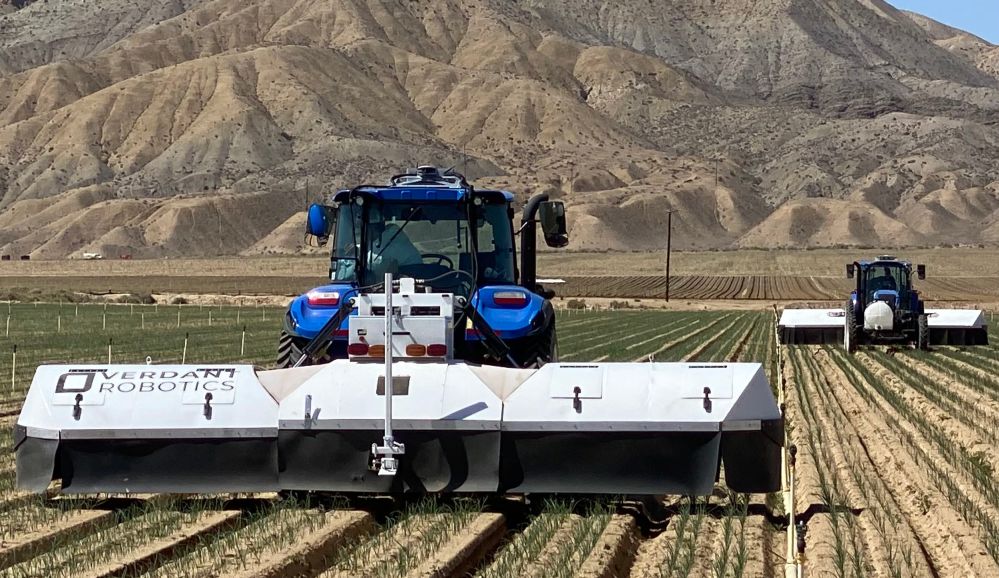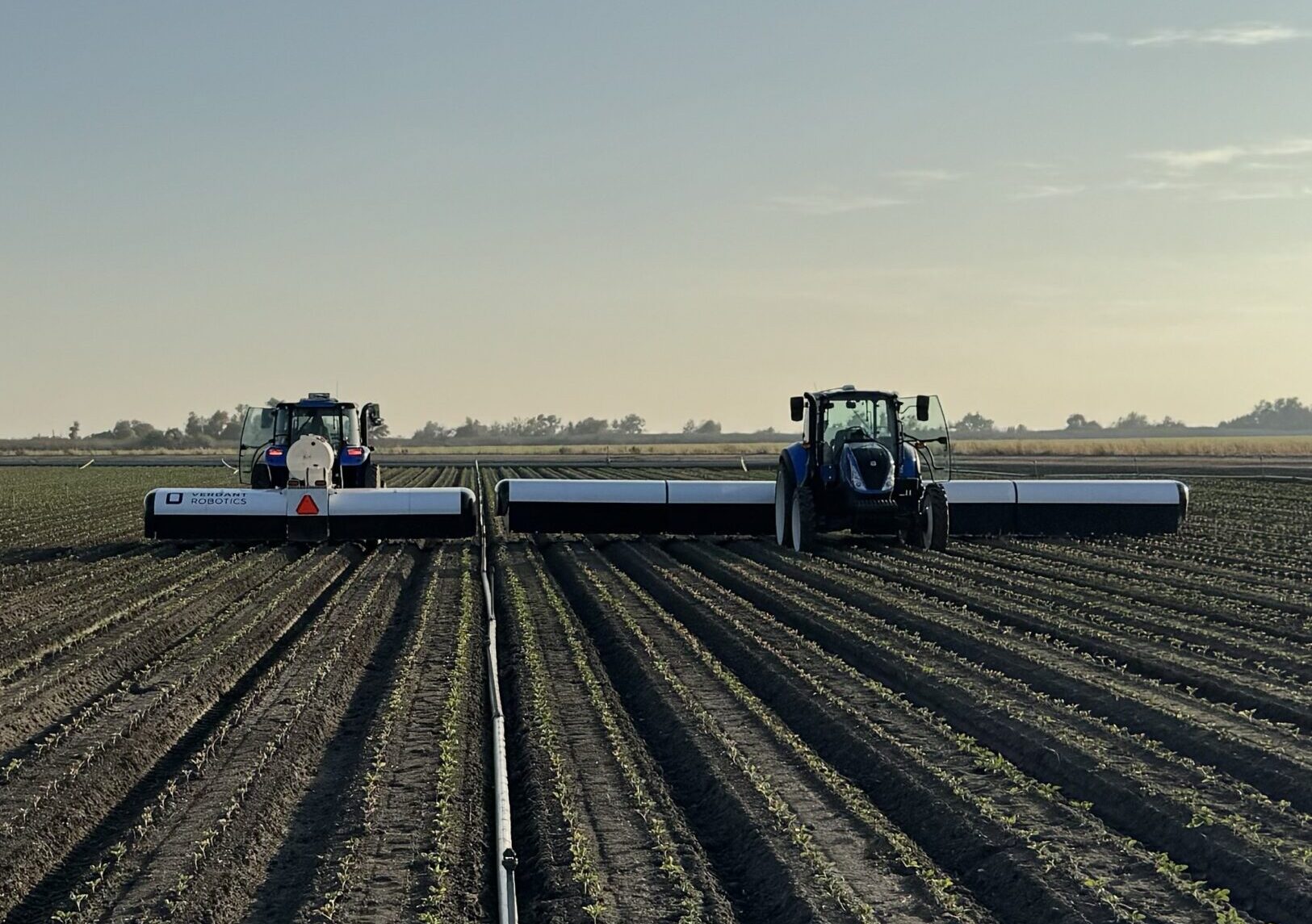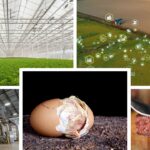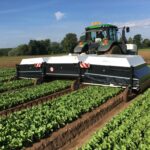When it comes to farming, says Verdant Robotics cofounder Dr. Gabe Sibley, the biggest pain points are typically labor and input costs. "We squarely address both." The post Meet the founder: Verdant Robotics’ Gabe Sibley on NASA rovers, self-driving...

[Disclosure: AgFunderNews‘ parent company AgFunder is an investor in Verdant Robotics.]
“There’s always been a prediction of the all-singing, all-dancing general purpose humanoid robot that can solve all of our problems,” says Verdant Robotics cofounder Dr. Gabe Sibley. But if you want to make a more immediate impact—and a profit—the smart money is on bots that provide “specific solutions for specific problems.”
And when it comes to farming, he says, the biggest pain points are typically labor and input costs. “We squarely address both.”
By using smart-spraying systems attached to the back of tractors that can target weeds with remarkable precision using computer vision and machine learning, he says, Verdant Robotics can obviate the need for back-breaking hand-weeding of high-density crops such as carrots, and slash input costs by enabling farmers to use dramatically fewer inputs, whether fertilizer, insecticides, herbicides, or pollen.
By effectively indexing the crop (creating a 3D model of what’s happening in the field over time, and tracking how specific actions lead to better outcomes), the technology “can also enable farmers to develop strategies that lead to higher yields or larger produce—things that increase value as well as just addressing pain points,” he says.
AgFunderNews (AFN) caught up with Sibley (GS) to talk about driving on other planets, self-driving cars, and the ag robotics landscape.
AFN: What first got you interested in robotics?
GS: I was teaching computer science to high school and junior high kids one summer when the Mars Sojourner [rover] landed with Pathfinder, and I had this realization that you could have a career in the robotic exploration of the solar system, and I was like, Sign me up! What could be cooler? And so that focused my schooling on robotics and AI, machine learning, computer vision… technologies that could create autonomous mobile machines that can do things like drive on other planets.
I moved to Southern California just to be next to JPL [NASA’s Jet Propulsion Laboratory], and I ended up doing a PhD at USC [The University of Southern California] and spending about five years at JPL. I loved it, it was absolutely awesome.
Ironically, at NASA, most of my work was actually for the DOD [US Department of Defense] and at the request of DARPA [R&D agency of the DOD], we started a small company that did contract engineering for various government organizations doing robotics, mechatronics, software, hardware, and mechanical platforms.
Next I returned to academia, where I did a postdoc research fellowship at Oxford [University in the UK] before moving back to the US as a professor at George Washington University.
AFN: What prompted your next career move?
GS: For the longest time, there were really only space and military applications for robotics, especially for mobile autonomy. But then, maybe 15 years ago, the likes of Google and Toyota started to fund our research, and industry really woke up to computer vision and NLP [natural language processing].
At some point, I started to notice that instead of my students peeling out and going to JPL or Sandia [a contractor for the US government’s Nuclear Security Administration] or academia, they were starting their own companies.
I started to realize that perception and control technology is going to have a far bigger impact, so I thought maybe it’s time to go to industry, so I was asked to cofound a company called Zoox, which was a self-driving car company out of Stanford AI Lab. Initially I said, no, I’ll be an advisor, and then I joined six months later anyway, and I absolutely loved putting that team together. The first 200 people that joined that company were pulled from the best of the best, because at that point, there was just Waymo and Zoox [in self-driving cars].
But ultimately, I came to understand that the challenges in self-driving cars—fielding an autonomous system at scale into society that’s potentially lethal—requires a very high bar, appropriately, around safety, and it became clear that this technology was not going to land very quickly. I really wanted to see my life’s work have an impact more quickly, so I left and started a company called Zippy [autonomous last-mile delivery vehicles], where I figured let’s reduce the liability and move packages instead of people!
In a very short period of time, we had built a sidewalk rover doing deliveries for Postmates and DoorDash, but to make it a really scalable business, at least in the US, you need to use roads, not sidewalks, so you’re back to self-driving cars yet again! At which point I decided to sell that company to Cruise Automation [General Motors].
AFN: And finally to ag robotics… why?
GS: About that time, I was working with a company called Moog that builds the world’s best hydraulic servo valves; they have just amazing technology and capabilities, and they said the right vertical to apply all this technology to is in fact, agriculture.
So they introduced me to [soon to be Verdant Robotics cofounder] Curtis Garner, who was operations manager at [leading tomato processing co] Morning Star and he really opened my eyes to the scale of the challenges. We spent six months on the road just trying to listen to farmers and understand the problems that it makes sense to tackle with this technology.
 The Verdant Robotics Sharpshooter smart sprayer targets weeds with millimeter accuracy, reducing chemical use by up to 96% for both organic and conventional growers, claims the startup. Image credit: Verdant Robotics
The Verdant Robotics Sharpshooter smart sprayer targets weeds with millimeter accuracy, reducing chemical use by up to 96% for both organic and conventional growers, claims the startup. Image credit: Verdant Robotics
AFN: What area of ag robotics did you focus on at Verdant Robotics and why?
GS: At that point, there was still a lot of focus on harvesting, but we looked at all the different things you could do with robotics and ultimately opted to focus on non-contact applications. As soon as you get into dexterous mobile manipulation, the complexity goes way up, the cost goes way up, and your scalability goes way down. So the folks who were looking in that space did not have very good gross margins.
When we started looking at what farmers and growers were spraying on crops, whether it’s herbicides, insecticides, fertilizer, pollen… we realized we could have a massive impact if we could find a way to do this more efficiently and with greater specificity.
So it was not only an opportunity to save growers a whole bunch of money just through efficiencies and labor costs, but also an opportunity to reduce input costs [by far more precise application of costly inputs] and drive higher yields.
AFN: What’s the ROI for growers/farmers for using your smart sprayers?
GS: The number one and number two costs in farming are labor and inputs, and we squarely address both. By spraying very precisely—to the millimeter—you can use significantly less of whatever input you’re using. By digitizing the crop and tracking how specific actions lead to better outcomes, we can also enable farmers to develop strategies that lead to higher yields or larger produce—things that increase value as well as just addressing pain points.
There was a time where it [the conversation about ROI] was predominantly focused on labor, but as input costs went through the roof a few years ago, I had CEOs saying we’re more concerned now about fertilizer prices.
 Verdant Robotics’ smart sprayers in action. Image credit Verdant Robotics
Verdant Robotics’ smart sprayers in action. Image credit Verdant Robotics
AFN: Tell us about your first prototype…
GS: Initially it was an array of [fixed] nozzles and we kept increasing the resolution for increased accuracy that you need to put a dollop of pollen on an apple blossom, but it was unwieldy.
So we took a step back and shifted to an aimable mechanism or turrets that allowed us to instead of just opportunistically addressing a line of targets, we could shoot from different angles, over things, underneath things, and that was a game changer, as suddenly all these three dimensional structures were now addressable.
It also made it way more flexible, because the same systems were designed to work in orchard crops such as apples [where the target is a well above ground] and with carrots [where the targets are in the ground], you just attach it to the back of a tractor. It’s a general-purpose spraying implement that’s broadly applicable across all different types of crops and each of these nozzles is making 10 to 20 shots per second.
For apples a key application is thinning, so that’s a combination of spraying fertilizer and pollen. The pollen is applied to select which apples should grow and the fertilizer, ironically, is to make them infertile. That allows you to select exactly which apples you want to go through the season, and the carbohydrate energy in the tree is then directed towards the most valuable apples.
And then that same machine we just took and pointed at the ground to work on carrots, garlic, onions and leafy greens. In carrots, currently, it’s mostly used for weeding.
AFN: Describe the latest machines…
GS: Imagine a pair of downward facing cameras, very high resolution, very high frame rate, attached to a tractor moving through a field. They see the ground, the crop, the weeds, so it’s spatial, you have a 3D model of your crop; but also temporal, as you’re tracking it over time.
There’s also some high-speed stabilization that goes at much higher frame rates so you can understand where everything is even while you are waiting for images to be processed, plus there’s the detection and classification of everything the cameras see.
Then you’re layering on top of that the whole decision-making system that’s deciding where to apply inputs. Our bull’s eye metric is 95% of the input was delivered within seven millimeters, and often it’s much much better than that.
Imagine something about the size of your pinky fingernail. We want a splat pattern [for applying the inputs to the target] of about that size.
AFN: Where does the machine learning (ML) part come in?
GS: In some senses, it’s not very complicated. You need to accumulate a large quantity of labeled data, which is basically human beings saying ‘this is a carrot, whereas this is a weed,’ and then train the computer vision model to detect and classify those as well as each pixel.
Then we refine those models over time to factor in what we call long-tail event. To give you an example, a while back, we went into a field and it had been frosty in the morning and it turned the carrot tops a purple color. Our machine had never seen purple carrots and it went out and classified them as weeds and started happily shooting them [with weedkiller]. Automatic flags went up and it stopped and very quickly, and we were able to say, this is a purple carrot, here’s a bunch of examples of what that looks like, and you’re not going to shoot them ! The model continually refines and takes those long tail events into account.
So [for any given crop] there’s the beginning part where you train models [to distinguish between that crop and weeds, for example] but then there’s improvements over time as we look at different soils, environments, lighting conditions, and so on.
AFN: Which crops are you focusing on and why?
GS: We’re going after crops where the ROI for the grower can be measured in less than a year. We see the most potential in high density crops like carrots, which might be less than an inch apart, so you might have crews crawling on their hands and knees picking weeds in 110-degree weather.
AFN: What is your business model at Verdant Robotics?
GS: Initially we developed a Robotics as a Service (RAAS) model but we’re now switching to direct sales. Right now, growers are opting mostly for the 20-foot weeding sprayer. There are plans for wider machines, and there are also upgrades coming this year that make these machines significantly faster. Our first deals are being closed right now!
AFN: How robust do these machines need to be?
GS: They have got to be insanely robust, so a huge amount of effort goes into making sure they can deal with shock and vibration. They have also got to be able to withstand high pressure chemical washing, a wide range of temperatures, and a dusty environment, which is a very tall bar for any mechanical and electrical system with delicate sensing computing platforms. You can’t overestimate the difficulty in that.
AFN: Who’s the target customer for Verdant’s smart sprayers?
GS: For farms of 500 acres or more, it’s pretty easy for this to make economic sense. On smaller farms that are in co-ops or in partnerships with other farms, it also makes sense. The value is pretty high for any grower, but it’s higher for growers that have high weed pressure and crops that are difficult to service otherwise, such as garlic, carrots, onions, leafy greens, broccoli, cauliflower, all the specialty crops here in California.
We’ve also done work in almonds, cherries, pears, and apples.
AFN: What’s the competitive set?
GS: You’ve got companies using robotics for mechanical weeding with knives or with lasers. But spraying has broader applications because you can’t apply fertilizer or pollen with a laser or a knife. And so we focused on that because it gives us a much broader canvas. We’re not just doing weeding; it’s just one of maybe 100 or 1,000 applications you can do when you’re talking about inputs.
Second, when it comes to weeding with lasers, it’s always going to be slow because it takes time to burn things. And as you get to increasingly powerful lasers, you require large amounts of power.
We did laser weeding for a while but quickly realized we could be anywhere from 30-50 times faster through the field using spraying versus lasers. And that metric of acres per hour is by far the most important metric that drives so much of the unit economics. You can’t compete on acres per hour if you’re going to use photons to kill weeds.
As for spraying, we’re not aware of any other spraying systems that can work in high density crops like ours. There’s nothing that has the type of precision we have. There are fixed grid sprayers but they have 20-30 times less accuracy.
AFN: What are the potential bottlenecks for you? Manufacturing the sprayers at scale?
GS: We have a variety of contract manufacturers that we work with that are fantastic, that are ready to scale. When we go beyond direct sales, we also need to be thinking about who are our partners for the long term from a sales perspective to allow us to take this technology all over the world. But the manufacturing side of it, we don’t think is the bottleneck.
AFN: How have you funded the business so far?
GS: We’ve raised $48.5 million so far [most recently in a Nov. ’22 $46.5 million series A round led by Cleveland Avenue] and we will start fundraising again next year. If we were to absolutely hit our marks, we’d be cashflow positive without raising money and be raising for growth. And so that’s the Verdant path. The value is pretty clear, so as long as we are demonstrating that to growers, the sales side is pretty straightforward and we have a pretty healthy deal pipeline.
Investors are looking at revenue and margins, TAM [total addressable market] and SAM [serviceable addressable market] and trying to understand is this something that’s going to be cashflow positive within line of sight?
AFN: What’s the future of ag robotics?
GS: I think there’s always been a prediction of the all-singing, all-dancing general purpose humanoid style robot coming to solve all of our problems, but if you look at what’s actually happened historically, you see engineering building specific solutions for specific problems.
However, we do live in a time period where we’re seeing pretty radical changes in terms of AI, and many credible businesses are going after essentially that general purpose dexterous humanoid robot, so as they say, the future ain’t what it used to be!
Still, if I were to put money down, I would say that people who are focusing on solving specific problems are going to have an impact more quickly, so very clever mechatronic solutions for harvesting specific crops, for example.
AFN: What about robotics in indoor ag?
GS: There are opportunities for very precise delivery of inputs indoors and outdoors, but I have always been a little skeptical of business models that rely on two cents per kilowatt energy to be cost effective.
The post Meet the founder: Verdant Robotics’ Gabe Sibley on NASA rovers, self-driving cars, and ag robots: ‘They have to be insanely robust’ appeared first on AgFunderNews.













